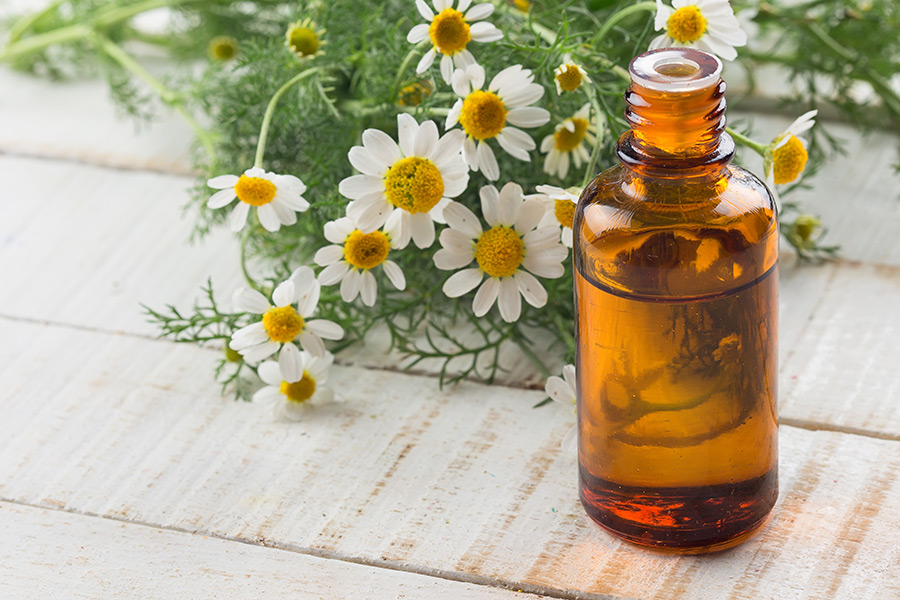
With its agreeable taste and apply scent, camomile makes a comforting tea. A cup of camomile tea at bedtime soothes frayed nerves and promotes sleep. But camomile’s benefits don’t end there. Scientists have identified more than a dozen active chemical compounds within its daisy-like flowers that not only take the edge off stress but can soothe a stomach upset almost as fast as you can say Pepto Bismol.
What’s it good for?
- belching
- boils
- conjunctivitis
- foot pain
- gum problems
- hives
- indigestion
- inflammatory bowel disease
- menstrual problems
- peptic ulcers
- psoriasis
- rosacea
- teething
A chemical in camomile called apigenin calms the central nervous system and makes it easier to fall asleep at night. If you feel really wound up, drink a cup of camomile tea or relax in a warm bath doctored with several cups of camomile tea, 10 drops of camomile oil or a handful or two of camomile flowers. The essential oil penetrates the skin and takes the edge off anxiety and stress.
More uses inside and out
Camomile doesn’t just help you to calm down. Several of its chemical compounds, especially one called bisabolol, act as antispasmodics: this means that they relax the smooth muscles that line the digestive tract and uterus, easing after-meal stomach ache or soothing menstrual cramps. A cup or two of camomile tea a day may also reduce the stomach-eroding effects of aspirin and related drugs – useful for people with arthritis or other painful conditions who need to take painkillers every day.
Because of its anti-inflammatory and antiseptic powers, camomile is also very useful for a number of other minor health complaints.
- Rashes and burns Camomile can benefit your skin as well as your intestinal tract. When camomile is applied externally in the form of camomile cream or a compress made with strong camomile tea, it helps cuts, burns and rashes to heal more quickly. If you have mild sunburn, mix camomile oil (sold in health-food shops) with equal parts almond oil or another neutral carrier oil. Apply it to reddened skin to reduce the inflammation that causes itching.
- Skin irritation In Germany, where herbs are widely used in mainstream medicine, doctors often recommended a camomile-based cream called kamillosan for wounds or inflammation caused by eczema, contact allergies and post-radiation treatment skin damage. Small amounts of camomile oil can be applied to treat skin ailments such as boils.
- Infections A wash of camomile kills some of the bacteria and fungi that cause eye or skin infections. Camomile tea can be used as a mouthwash to soothe inflamed gums, help fight gum disease and speed up the healing of mouth ulcers.
Buying and using camomile
You can buy camomile tea bags or look for the dried flowers in health-food shops. Some people have successfully grown camomile in the garden by simply sprinkling the contents of a bag of camomile tea on the soil. Note that there are two different camomile plants: Roman camomile (Chamaemelum nobile) and German camomile (Matricaria recutita), also known as Hungarian camomile. While the two plants may look almost identical, German camomile is more popular and is thought to have greater healing powers.
You can find camomile cream in health-food shops, but it’s just as easy, and less expensive, to make your own skin-healing brew. Pour a cup of boiling water over a heaped tablespoon of camomile flowers. Let it steep for 10 minutes, wait until it cools to room temperature, then soak a cloth in the tea and apply it to a cut, rash or burn for about five minutes.
A media uproar followed a report in the US Journal of Allergy and Clinical Immunology that camomile tea might cause a potentially fatal allergic reaction in people allergic to ragweed. But when scientists looked at the available data, they were able to identify only a handful of reactions (and none of them fatal) to German camomile, the variety commonly used in the UK. If you are allergic to plants of the Asteraceae family – asters and chrysanthemums – then do not use camomile.
Cautions and Side Effects
Taken by mouth can cause a reaction if you are allergic to related plants, such as aster and chrysanthemum. Camomile contains an anticoagulant use with caution if you have a blood-clotting disorder or take anticoagulant drugs.
